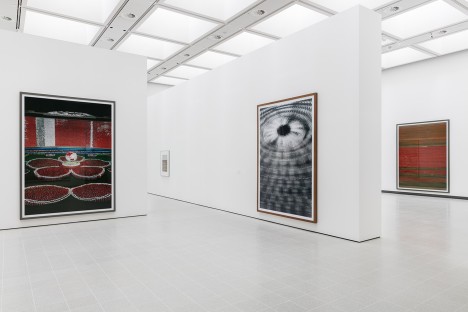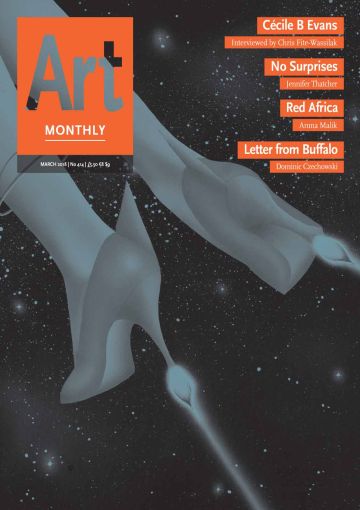Review
Andreas Gursky
Martin Herbert reviews the German photographer’s Hayward Gallery retrospective

‘Andreas Gursky’ installation view, Hayward Gallery, London
In 1984, when he was 29, Andreas Gursky took the photograph that opens this 68-work retrospective. Klausen Pass is an image of a hillside in the Swiss Alps dotted with figures who, the Leipzig-born artist realised when he printed the negative, constellate perfectly across the landscape. They’re less people than compositional devices, though still humans wayfaring through nature’s grandness. Twenty-nine years later, in 2013, Gursky composited together SH 1, a startlingly pin-sharp, post- human image in which Iron Man and his fictional squeeze, Pepper Potts, embrace in front of a tropical backdrop of ocean and palm trees tinted toxic lavender. Cold, acidic, weirdly sad, it’s a photograph that barely makes sense. Contained between these two images is Gursky’s story, and, if you’re susceptible to his art’s claims, ours too.
Arrayed through the Hayward’s swish refit – marked by the reintroduction of natural light via pyramidal skylights upstairs – Gursky’s show retreats from the natural as it goes. His grand subject is, of course, mankind’s presence on Earth, signs of mortal inhabitation in all registers. Here we are, pluckily sailing towards the rim of a giant, thrashing waterfall (Niagara Falls, 1989), organising ourselves into unequal industrial societies (the many-hued labyrinth of wiring in the factory scene Karlsruhe, Siemens, 1991, the hangar-like Ikea wicker workshop in Nha Trang, 2004) and constructing steadily more intricate financial systems, from Tokyo, Stock Exchange, 1990, to Chicago Board of Trade III, 2009. Here we are at the Madonna concert. Mass-farming cows. In front of a dazzling range of flight choices at Frankfurt airport. Looking at the monuments at Giza that our predecessors built. As several of Gursky’s teeming vistas of garbage point out, we fucked up the planet along the way; yet we’re still here, just about.
That’s just one through-line, though, since Gursky’s art is full of careful counterweights. He truly finds his feet a couple of rooms in, with Salerno I, 1990, where his telephoto lens flattens a view of an Italian port town’s harbour into a toytown of colourful shipping containers, rich in artificial oranges against the pale blue of the sea, and tightly parked brigades of colour-coded cars. Mountains rise and fall indifferently behind. It’s an image that will absorb any amount of viewing and yet, in what becomes a typical move, it is hard to actually look at: without a centre, the eye skidding untethered as in a Jackson Pollock. Gursky increasingly pushes for this effect by artificial means, whether by collaging views of a massive housing development in Paris, Montparnasse, 1993, a hyper-complex Mondrian laced with Rear Window voyeurism, or in the insane candy-coloured chaos of Amazon, 2016, showing the retail giant’s warehouse and its seemingly illogical if functional filing system.
That painting is frequently on Gursky’s mind is hard to miss, from the scale of his photographs (here, in a satisfying way, often printed specifically for the scale of the rooms) to sardonic statements like Turner Collection, 1995, in which three of the painter’s wild and windswept works are gentrified by gold frames and a museum’s neat wooden floor. What this conversation might mean, though, will only become clear later. As the show progresses, the digital manipulation Gursky took up in 1992 becomes more and more pronounced (although sometimes, trickily, he hardly uses any). F1 Pit Stop, 2007, was shot in more than one place and clusters far more than the prescribed number of Formula One personnel around each sleek vehicle; it depicts not the baroquely technical subject itself but Gursky’s subjective feeling for its convolutedness. The land, too, has become technologised, as in Les Mées, 2016, a spectacular prospect of black solar panels conforming to the curves of a rural landscape. Bahrain I, 2005, synthesises discrete views of an incongruous desert racetrack into a cubist rumpus of perspectives.
It’s in such images, and in works like Storage, 2014, that Gursky’s second act as an artist asserts itself: his tracking of what reality has morphed into. Structured as a complexity of overlapping, receding steel grids, Storage is interspersed with vertical slivers of Gursky photographs that we have seen already by this point. It looks like some kind of next-level real estate for an artist of his privileged status; it also looks patched together on a computer. The reminder of Gursky’s station in our hyper-capitalist era, which he indicts elsewhere, is unhelpful. But it also speaks, as per the thesis in Adam Curtis’s 2015 documentary Bitter Lake, to a world whose interlinked intricacy now exceeds our ability to comprehend it. Storage is an alienating photograph, and I’m not sure it’s a good one (in recent years Gursky has misfired a few times, particularly his would-be iconic series of rippling waterscapes), but it delivers a mode of semi-abstraction that feels more contemporarily abstract than his clever pictorial nods to art-historical abstract painting elsewhere.
Those nods persist, as in the highly fabricated Review, 2015, which drops four German chancellors, seen from behind, in front of Barnett Newman’s Vir Heroicus Sublimis, 1950-51. As you mosey back through the show, such painterly doublings adumbrate Gursky’s plastic attitude to photography – that it’s not about recording the world but bending the image to fit a perception – but also do something else, serving as a plaintive memorial. A locus of the organically manmade, painting drifts through these images like a ghost, or a memory, at a time more strongly reflected in SH 1, with its artificial characters in artificial space. Similarly, Gursky’s survey of his own surveying, which variously ventures as far as North Korea and to an altitude 35,000km above the planet, might superficially suggest that the whole world is here. Yet much of it isn’t, much of what is can’t quite be trusted, and the more you see of it, the less you understand.
‘Andreas Gursky’ is at Hayward Gallery, London, 25 January to 22 April 2018.
Martin Herbert is a writer based in Berlin.
First published in Art Monthly 414: March 2018.









